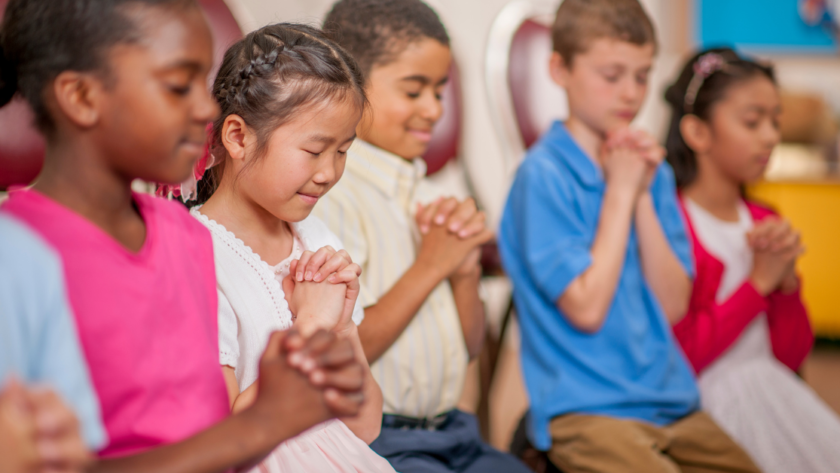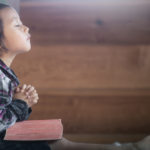As an educator and parent who has implemented Christian meditation practices with kindergarteners, I’ve seen the profound impact these simple exercises can have on young children. From improved emotional regulation to enhanced focus and a deeper connection with God, the benefits are truly remarkable.
The Foundations of Christian Meditation for Little Ones
Christian meditation for kindergarteners creates space for children to experience God’s presence in their daily lives. We focus on simple, multisensory experiences that engage a child’s natural curiosity and imagination.
Storytelling as a Meditation Tool
Bible stories provide rich narratives that children can easily relate to and visualize. For example, we might invite children to imagine themselves in the story of Jesus calming the storm.
As they close their eyes, we guide them to feel the gentle rocking of the boat, hear the wind and waves, and experience the peace that comes when Jesus speaks.
Breath Awareness for Young Children
While young children may not grasp the concept of mindfulness, they can understand the idea of “balloon breathing.” We encourage them to place their hands on their bellies and imagine inflating a balloon as they breathe in, then slowly letting the air out as they exhale. This simple exercise introduces the concept of focused breathing and helps children regulate their emotions.
Multisensory Meditation Techniques
Kindergarteners learn best through hands-on, multisensory experiences. Here are some effective Christian meditation techniques that engage multiple senses:
Prayer Beads
Create simple prayer bead bracelets with children, using different colored beads to represent various prayer intentions. For example, red beads might represent family, blue for friends, and green for the world.
As they touch each bead, guide them in offering a simple prayer.
Nature Walks
Take children on a “God’s creation” walk, encouraging them to use all their senses to appreciate the natural world. Ask them to listen for birds, feel the texture of leaves, and smell flowers, relating each experience back to God’s love and creativity.
Body Prayer
Teach children simple gestures to accompany their prayers, such as reaching up high for praise, hugging themselves for God’s love, or extending their hands to pray for others. This kinesthetic approach helps active children engage more fully in the meditation process.
Meditative Coloring
Provide simple coloring pages depicting Bible scenes or Christian symbols. As children color, play soft worship music and encourage them to think about God’s love.
Gratitude Jars
Create a class gratitude jar where children can add small objects or pictures representing things they’re thankful for. During meditation time, invite children to choose an item and share their gratitude with God.
Overcoming Challenges in Kindergarten Meditation
Implementing Christian meditation practices with young children comes with it’s own set of challenges. Here are some common hurdles and strategies to overcome them:
Short Attention Spans
Keep meditation sessions brief, typically no longer than 5-10 minutes. Frequent, short sessions are more effective than occasional long ones.
You might start with just 2-3 minutes and gradually increase the duration as children become more comfortable with the practice.
Fidgety Children
Incorporate movement into your meditation practices. Use “body prayers” or simple yoga-inspired poses to help active children engage.
For example, you could teach children to stand like a tree while praying for strength, or to stretch their arms wide while thanking God for His big love.
Varying Levels of Spiritual Maturity
Offer a range of activities that cater to different levels of understanding and engagement. Some children may be ready for simple contemplative practices, while others might benefit more from active, sensory-based meditations.
Always have alternative options available to confirm every child can join meaningfully.
Parental Concerns
Communicate clearly with parents about the goals and methods of Christian meditation for young children. Offer resources for continuing practices at home, making it a family activity.
Consider hosting a parent workshop to show the techniques and address any questions or concerns.
Maintaining Consistency
Create a regular “meditation time” in your daily schedule. Use visual cues, like dimming lights or playing a specific song, to signal the transition into meditation time.
A consistent routine helps children know what to expect and can reduce anxiety or resistance.
Adapting Meditation for Different Learning Styles
Every child is unique, and what works for you may not work for another. Here are some ways to adapt Christian meditation practices for different learning styles:
Visual Learners
Use picture books, meditation cards, or simple icons to represent different prayer intentions or Bible stories. Create a “prayer wall” in your classroom with images that children can focus on during meditation time.
Auditory Learners
Incorporate music, spoken guided meditations, or simple chants into your practice. You might record short, age-appropriate guided meditations that children can listen to individually or as a group.
Kinesthetic Learners
Focus on movement-based meditations, such as “prayer walks” around the classroom or simple liturgical dance movements. Create a “prayer path” with different stations where children can engage in physical activities related to prayer or Bible stories.
Tactile Learners
Provide objects for children to hold during meditation, such as smooth stones, small crosses, or textured prayer cards. Create a “prayer box” filled with various tactile objects that children can explore during meditation time.
Building a Foundation for Lifelong Spiritual Growth
By introducing Christian meditation practices in kindergarten, we’re laying the groundwork for a lifetime of spiritual growth. These early experiences shape a child’s perception of prayer, their relationship with God, and their ability to find peace and guidance in their faith.
As children grow, these foundational practices can evolve into more complex forms of Christian meditation and contemplative prayer. The child who learned to appreciate God’s creation through nature walks may grow into a teen who finds solace in outdoor retreats.
The kindergartener who practiced gratitude might become an adult who naturally turns to thankfulness in times of stress.
Practical Tips for Implementing Christian Meditation in Kindergarten
Creating a Sacred Space
Designate a special “prayer corner” in your classroom. This area should have comfortable seating, soft lighting, and age-appropriate spiritual objects.
You might include a child-friendly Bible, a cross, and some nature elements like plants or stones.
This dedicated space helps children transition into a prayerful mindset.
Using Sensory Cues
Employ a special chime or bell to signal the beginning and end of meditation time. The sound can help children focus their attention and create a sense of ritual around the practice.
You could also use scented oils or candles (battery-operated for safety) to engage the sense of smell and create a calming atmosphere.
Encouraging Reflection
After meditation sessions, provide opportunities for children to share their experiences. This could be through verbal sharing, drawing pictures, or even acting out what they felt or imagined. Remember to make this optional – some children may prefer to keep their experiences private.
Integrating Meditation into Daily Routines
Incorporate brief meditation moments into transitions between activities. This can help children refocus and calm down throughout the day.
For example, you might lead a 30-second breathing exercise before starting a new lesson or after recess.
Adapting to Individual Needs
Be flexible and willing to adjust your approach based on the children’s responses and needs. Some days, a more active form of meditation might be necessary, while other times, a quiet, reflective practice might be more suitable. Pay attention to the energy in the room and adapt accordingly.
Involving Families
Send home simple meditation activities that families can try together. This could include a guided bedtime meditation script, a nature scavenger hunt with reflection questions, or instructions for creating a family gratitude jar.
Encouraging family participation reinforces the practices learned at school and helps create a supportive environment for spiritual growth.
Celebrating Progress
Acknowledge and celebrate children’s engagement with meditation practices. This could be through verbal praise, special stickers, or a class chart tracking group participation.
Remember to focus on effort and engagement as opposed to any perceived “success” in meditation.
Using Technology Mindfully
While it’s important to limit screen time for young children, there are some suitable ways to incorporate technology into Christian meditation practices. You might use a tablet to display calming nature scenes or religious artwork during meditation time, or play soft instrumental worship music through speakers.
Connecting with the Liturgical Calendar
Align your meditation practices with the liturgical calendar. During Advent, focus on waiting and preparation.
In Lent, explore themes of reflection and growth.
This helps children understand the rhythms of the Christian year and deepens their spiritual experience.
Encouraging Peer Support
Foster a sense of community around meditation practices. You might pair children as “prayer buddies” who can check in with each other about their experiences.
This provides support and helps children learn to articulate their spiritual experiences.
The Role of the Teacher in Guiding Christian Meditation
As the facilitator of these meditation practices, your role is crucial in creating a safe, nurturing environment for spiritual exploration. Here are some key aspects to consider:
Modeling Meditation
Children learn by example, so it’s important that you join in the meditation practices alongside them. Let them see you engaging sincerely with the exercises, showing that meditation is valuable for adults as well as children.
Using Gentle Guidance
When leading meditations, use a soft, calm voice. Speak slowly and clearly, allowing plenty of time for children to process and respond to instructions.
Remember that silence is also valuable – don’t feel the need to fill every moment with words.
Respecting Individual Experiences
Each child will experience meditation differently. Some may have vivid imaginary experiences, while others might simply feel calm or relaxed. Validate all experiences and avoid comparing children’s responses.
Addressing Difficult Emotions
Sometimes, meditation can bring up challenging emotions for children. Be prepared to offer comfort and support if a child becomes upset during or after a meditation session.
Have strategies ready, such as offering a hug, providing a quiet space to talk, or engaging in a calming activity.
Continuing Your Own Spiritual Growth
To effectively guide children in Christian meditation, it’s important to maintain your own spiritual practice. This deepens your understanding of meditation and helps you stay grounded and centered when working with energetic young children.
The Impact of Christian Meditation on Kindergarteners
Through consistent practice, Christian meditation can have a profound impact on kindergarteners’ spiritual, emotional, and cognitive development. Here are some of the benefits I’ve observed:
Enhanced Emotional Regulation
Children who regularly engage in meditation practices often show improved ability to manage their emotions. They learn to pause and breathe when feeling overwhelmed, as opposed to immediately reacting.
Increased Empathy and Compassion
Practices like praying for others and expressing gratitude help children develop a greater awareness of others’ feelings and needs. This often translates into more caring behavior towards classmates and family members.
Improved Focus and Attention
The concentration skills developed through meditation can carry over into other areas of learning. Many teachers report that children who practice meditation are better able to focus during lessons and finish tasks.
Deeper Spiritual Awareness
Regular engagement with Christian meditation helps children develop a more personal relationship with God. They begin to see prayer not just as a formal activity but as an ongoing conversation with a loving Creator.
Reduced Anxiety
For children who struggle with anxiety or worry, meditation can provide valuable coping tools. Learning to focus on God’s presence and love can be deeply reassuring for young children.
Enhanced Creativity
The imaginative aspects of many Christian meditation practices can stimulate children’s creativity. This often spills over into their artwork, storytelling, and play.
Improved Sleep
Parents often report that children who practice meditation at school have an easier time settling down at bedtime and experience better quality sleep.
Greater Self-Awareness
Through practices like body prayer and breath awareness, children develop a stronger sense of their physical selves and their internal states. This self-awareness is a valuable life skill that can support emotional intelligence and decision-making.
Addressing Common Concerns About Christian Meditation for Children
Despite the many benefits, some parents and educators may have concerns about introducing meditation practices to young children. Here are some common worries and how to address them:
“Isn’t meditation a non-Christian practice?”
Christian meditation has a rich history dating back to the early church. Explain that the practices you’re using are firmly rooted in Christian tradition and are focused on helping children connect with God.
“Are these practices age-appropriate?”
Assure parents that all activities are specifically designed for young children, taking into account their developmental stage and attention spans. Emphasize the playful, imaginative nature of many of the practices.
“Will this confuse children about prayer?”
Explain that meditation is introduced as one of many ways to connect with God, alongside traditional prayer forms. It revolves around expanding children’s spiritual toolkit, not replacing other practices.
“Is this taking time away from academic learning?”
Share research on the cognitive benefits of meditation, including improved focus and emotional regulation. These skills support academic learning across all areas of the curriculum.
“What if my child doesn’t want to participate?”
Stress that participation is always voluntary. Children are encouraged to engage in the practices but are never forced. Alternative quiet activities are always available.
Looking Ahead: The Long-Term Benefits of Early Christian Meditation
While the immediate benefits of Christian meditation for kindergarteners are significant, the long-term impact can be even more profound. By introducing these practices early, we’re equipping children with valuable spiritual tools that can serve them throughout their lives.
A Foundation for Lifelong Faith
Early positive experiences with prayer and meditation can help children develop a strong, personal faith that carries them through life’s challenges. The simple practices learned in kindergarten can evolve into more complex forms of spiritual engagement as children grow.
Emotional Resilience
The self-regulation skills developed through meditation can contribute to greater emotional resilience in later life. Children who learn to turn to God in times of stress may be better equipped to handle future challenges.
Spiritual Discernment
Regular practice of listening for God’s voice in meditation can help children develop spiritual discernment. This skill can guide them in making important decisions as they grow older.
A Sense of Divine Presence
Children who grow up with a regular meditation practice often develop a strong sense of God’s constant presence in their lives. This awareness can be a source of comfort and guidance throughout their lives.
Community and Belonging
Shared spiritual practices can foster a sense of community and belonging within the church. Children who grow up with these practices may find it easier to engage with faith communities as adults.
Key Takeaways
- Christian meditation for kindergarteners should be multisensory, engaging, and age-appropriate.
- Regular, short meditation sessions are more effective than occasional long ones.
- Adapt practices to suit different learning styles and individual needs.
- Clear communication with parents about the benefits and methods of Christian meditation is crucial.
- Early meditation practices lay the foundation for lifelong spiritual growth and emotional resilience.
People Also Asked
What is Christian meditation for kids?
Christian meditation for kids involves age-appropriate practices that help children connect with God through prayer, reflection, and mindfulness activities based on Biblical principles.
How can I teach my child to meditate on God’s Word?
You can teach children to meditate on God’s Word by using simple visualization techniques, memorizing short Bible verses, or creating art projects inspired by Scripture.
Is meditation okay for Christians?
Yes, meditation has a long history in Christian tradition. Christian meditation focuses on reflecting on God’s Word and presence, as opposed to emptying the mind.
At what age can kids start meditating?
Children can start simple meditation practices as early as 3-4 years old, with age-appropriate activities that focus on breath awareness, gratitude, and short guided visualizations.
How do you explain meditation to a child?
Explain meditation to a child as a special quiet time to talk to God, listen for His voice, and feel His love. You might compare it to sitting quietly with a best friend.
Can meditation help with ADHD in children?
Some studies suggest that meditation can help improve focus and reduce hyperactivity in children with ADHD, though it should be used alongside other treatments recommended by healthcare professionals.
How long should kids meditate?
For young children, start with very short sessions of 1-2 minutes and gradually increase to 5-10 minutes as they become more comfortable with the practice.
What are the benefits of meditation for kids?
Benefits of meditation for kids can include improved focus, better emotional regulation, reduced anxiety, enhanced empathy, and a stronger connection to their faith.
How can I make meditation fun for kids?
Make meditation fun for kids by incorporating movement, storytelling, art activities, and sensory experiences into the practice. Use props like stuffed animals or nature objects to engage their imagination.
Is guided meditation good for kids?
Guided meditation can be very useful for kids, as it provides structure and helps them focus their thoughts. Choose age-appropriate guided meditations with Christian themes.




